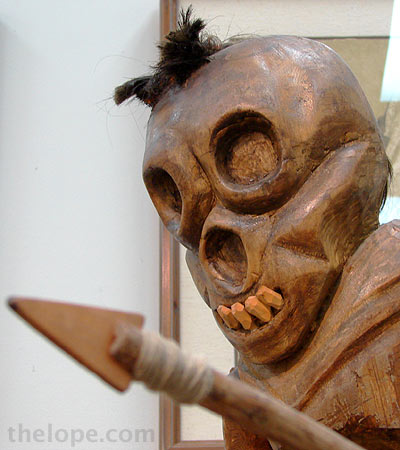Open up Google and type in “Doña Sebastiana” and peruse through the images that you get. It’s probably something like this:
Professor Carlo Severi’s lecture on the connection between art and social memory focused heavily on the relationship between christianity in Mexico and the depiction of Doña Sebastiana. The art and portrayal of Doña Sebastiana is fascinating as it brings about the question of the importance of death in Mexican Christianity. Christianity has traditionally focused on life and rebirth, such as the resurrection of Jesus Christ. Looking at Doña Sebastiana (or Santa Muerte as she is referred to sometimes) gives a completely different impression.
Anthropologically, this is an engrossing topic. To the Aztecs and the Mayans that occupied modern-day Mexico, death was a large part of religion and culture. Human sacrifices were not uncommon and both peoples prayed to their respective gods of death. The Aztecs’ death god was named Mictlantecuhtli, who ruled over all of the dead and was one of the more prominent gods in Aztec religion. The Maya believed in multiple death gods, all of which fell into two basic types: Hunhau and Uacmitun Ahau.
Mictlantecuhtli looked like this:
Seems somewhat familiar? He looks almost like Doña Sebastiana! What is so amazing about this is that this is evidence of cross-cultural traditions with respect to the Christian Mexicans and the Aztecs. This reveals how their ancestors, the Aztecs, actually influenced the Mexicans of today. When Christianity infiltrated Mexico and South America in the 17th century, the Aztec and Maya people were supposedly wiped out. With them, most of their traditions were thought to have disintegrated too.
Yet here is proof that the Aztecs did in fact leave their mark on society today. This is where the importance can be placed on social memory – the cultural emphasis placed on death transcended through every following generation and managed to influence the portrayal of Christianity in Mexico.
Now, the cult of Santa Muerte has reached the United States. Through migration and immigration, the belief in Doña Sebastiana has managed to spread across nations, past the United States/Mexican border and into America. Its influence has also extended to non-Latinos, specifically in Louisiana and Northern California.
Just like history has shown us, cultures and traditions carry on through time and location. The social memory of Doña Sebastiana, passed down for generations is a prime example of this, and Professor Severi’s talk on this was stimulating, captivating, and thought provoking.
References:
Picture 1: http://www.thelope.com/images/08-10-10-113.jpg
Picture 2: http://upload.wikimedia.org/wikipedia/commons/2/2f/MictlantecuhtliTemploMayor_B.jpg
BBC: http://www.bbc.co.uk/news/world-latin-america-22462181
Santa Muerta Webpage: http://lamericalatina.net/la-santa-muerte/
Delgado Arts: http://delgadoarts.wordpress.com/2011/08/15/dona-sebastiana-lady-sebastian/


